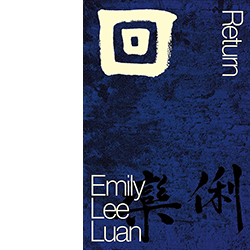Sorrow, Framed: A book review for Emily Lee Luan’s Return
I have an initial review of Emily Lee Luan’s Return at goodreads. But I’ve thought to further elaborate on it after my close reading of the book’s final poem, “From weeping into weeping.”
 Return (Nightboat Books, 2023)
Return (Nightboat Books, 2023)Emily Lee Luan’s book is like a framed picture. Where the book’s opening poems explain the picture’s frame. Which is sorrow. A deep family sadness rooted in Taiwan, which the poet will not escape, or the book won’t let her escape it. And, for me, this choice is one of the book’s biggest risks. Because sorrow is intense, and it is by its very nature a sentiment that overwhelms. A poem whose frame prepares the reader to be overwhelmed could easily not overwhelm the reader, because they’re just waiting for the affect. It turns out, however, Luan’s sorrow is saturating and pervasive. Which the poems direct me to read as the experience of generational trauma. It’s like water around her, or it’s her as water, or it’s what happens if you’re the main character in a story, and you jump into a well, and all you can do is explain the color of that water around you. And the character in the well? That’s sorrow. And all these are images used by Luan to elaborate on the source of sorrow, and to express its presence in her life, to fill the frame proposed at the opening with sorrow, to exhibit each poem like a portion of a Sorrow collage, a family bracketing the poet’s life with sadness, the poet always aware of the sadness that had built her life.
Many of the poems rely on a structure that orients the reader to this sorrow, and it works to always push sadness to the edge of entirety. For instance, many poems fold Chinese in, and it’s poetic structure that helps me navigate my English-only reading of those poems. The poem on page 27, about the poet’s mother, ends with the last three lines using the same set of Chinese characters. In a situation like that I might not be able to read the characters, but I can read the poetic gesture to refine through repetition and apposition. In my close reading of Return’s final poem, “From weeping into weeping,” there is a narrative structure that clearly describes the poet’s anticipation of sadness. How it will literally Return to her. And yet, I find my reading overwhelmed by each of the images, leading me to read closely using simultaneous lenses. These gestures to poetic structure are present throughout the book, whether it’s the Chinese displacing the English in a poem, or it’s form itself (with circular lines of text, for instance). It leaves the impression that Luan’s sorrow is indecipherable. Like Return is set to frame sorrow, and to express it. But there is still something inexpressible about sorrow.
Still, I don’t think this obviates the risk when a book sustains a thematic or tonal point as conventionally poetic as sadness. This is in no way a comment on how the poet has experienced this in her life. I’m mindful of a book giving voice to this subject and sustaining it. If a book proposes to center itself on sorrow, how much will the book’s frame lead the poems versus how much sorrow will be present because it can’t not appear. It’s like elegy and mourning in Marie Howe’s What the Living Do (W. W. Norton 1998). Every poem is grounds for Howe to revisit this horrible tragedy. And, for me, every poem in that book sustains the sentiment, because each circumstance feels like a fresh consideration of life, which is what the living must do after someone else has died. Like each poem shows the poet struggling with life in the face of what she knows about a horrible death.
In this book, Luan opens with sorrow as an immediate presence. Like the present tense of presence, and each poem is an expression of what the poet was encumbered with. As the book progresses into the middle sections, sorrow feels more like sadness, and maybe it’s the sadness of growing past childhood. A point that further complicates the presence of sorrow. Because an elaboration of growing into a young adult, where the clash of previous personhood as a child and teen rooted in a family structure contrasts and reshapes the sorrow carried by the new adult personhood borne out of separation. Part of reading the book, for me, is matching the sadness of someone living through their 20s with the sorrow described in the beginning of Luan’s book.
And then Luan closes with family legends based on a great-grandfather as a young adult, and a grandfather as a young adult, and a father, before he had met her mother. And I see what the poet has to reckon with as she lives through the transition to her adulthood. What is a story? What exactly is the sorrow these ancestors encountered, and how might her experiences in the United States be told in a legend?
The post Sorrow, Framed: A book review for Emily Lee Luan’s Return appeared first on theKalliope.



